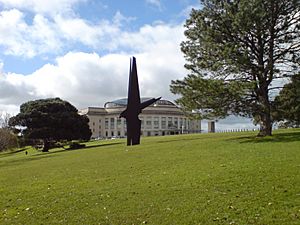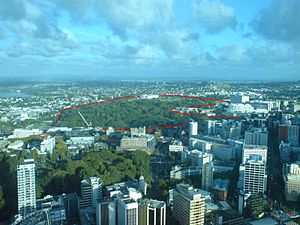Auckland Domain facts for kids
Quick facts for kids Auckland Domain |
|
|---|---|

Sculpture Kaitiaki by Fred Graham in the Auckland Domain, with the Auckland Museum behind
|
|
| Type | Public park |
| Location | Auckland, New Zealand |
| Area | 185 acres (75 hectares) |
| Created | 1843 |
| Operated by | Auckland Council |
| Status | Open year round |

The Auckland Domain is a very large and old park in Auckland, New Zealand. It covers about 75 hectares (185 acres), making it one of the city's biggest parks. You can find it in the central area of Grafton.
This special park sits on an ancient volcano called Pukekawa. The park includes the volcano's main crater and much of its surrounding ring.
The Auckland Domain is home to some cool places. The Auckland War Memorial Museum is a major attraction, sitting high up on the volcano's rim. Inside the old volcano crater, you'll find sports fields. The beautiful Domain Wintergardens are also here, with two amazing glasshouses full of plants. There's even a fernery built in an old quarry. Don't forget the duck ponds, which are fed by freshwater from the crater.
Contents
Discovering Pukekawa Volcano
The Auckland Domain is built on top of the Pukekawa Volcano. This is one of the oldest volcanoes in the Auckland volcanic field. Pukekawa has a large crater formed by explosions. It also has a surrounding ring made of volcanic ash and rock. In the middle of the crater, there's a small cone called Pukekaroro.
Long ago, the crater floor was filled with a lake of lava. Later, the western part of the crater became a freshwater lake. This lake eventually turned into a swamp. Over time, it filled up with mud and dirt. Europeans later drained the swamp to create the playing fields and parkland you see today. The duck ponds in the park are still fed by freshwater from this old crater.
A Glimpse into History
Māori Heritage
The Māori knew that Pukekawa was a great spot. The north side of the volcanic cone was perfect for growing kumara (sweet potatoes). The hill itself was used for storage and as a pā (a fortified village). The swamp in the crater provided eels and water.
The name "Pukekawa" comes from the Māori language. It means 'hill of bitter memories'. This name likely refers to tough battles fought between the Ngapuhi and Ngati Whatua tribes. A special totara tree was planted to remember these battles and the peace that followed. This tree, planted by Princess Te Puea Herangi, still stands on the central volcanic cone.
In 1828, the central cone was a place where northern and Waikato tribes met to make peace.
European Settlement
After Europeans bought the land from Ngāti Whātua, it was set aside as a public park in 1843. This was done by Governor FitzRoy. It was first called "Auckland Park" but soon became known as the "Auckland Domain." In the 1860s, springs in the Domain provided water for Auckland town. The old swamp was drained and became a cricket field.
The Auckland cricket team played all their home games here until 1913. The Auckland Acclimatisation Society started gardens in the Domain in 1862. These later became the Auckland Botanic Gardens. You can still see parts of their old layout today.
In the 1850s, Governor-General Thomas Robert Gore-Brown wanted to build a new Government House (where the Governor lives) in the Domain. He imagined a grand castle-like building. However, the project didn't happen because of money issues and worries about taking public land. So, the Auckland Domain stayed open for everyone to enjoy.
Many beautiful trees from other countries were planted in the Domain by the late Victorians. These have grown into a wonderful park landscape. New Zealand native trees have also been added. The wooden Cricket Pavilion was built in 1898 after an earlier one burned down.
In 1910, the Domain hosted New Zealand's first ever rugby league test match. Great Britain played against New Zealand during the 1910 Great Britain Lions tour.
In 1913, the Domain was the site of the Auckland Exhibition. This big event helped pay for many improvements to the park. The most important addition was the amazing Domain Wintergardens next to the duck ponds. The teahouse, built like an "ideal home," was meant to stay after the exhibition. It's an example of Arts and Crafts style.
During the 1920s and 1930s, a local businessman named William Elliot donated several marble statues. He also gave money to finish the Wintergarden complex. He funded the beautiful Art Deco entrance gates to the Domain. These gates were designed by Gummer and Ford. They have a bronze statue of an athlete by sculptor Richard Gross. You can also find other public artworks in the Domain.
The Auckland War Memorial Museum and Cenotaph are a major feature of the Domain. The large museum building, in a neo-Greek style, opened in 1929. It has been expanded and renovated over the years.
In 1940, a new road called "Centennial Drive" was planned to celebrate Auckland's 100th birthday. Trees were planted, but the road was never built. It is now a walking path.
A large water reservoir was built underground in 1952. It holds 18,500 cubic meters of water. This reservoir is still used today to supply water to Auckland's city center.
In 1970, a sensory garden was created for people who are blind. In 2005, a monument for the Auckland Regiment was put in place.
Exciting Events
The Auckland Domain has hosted many of New Zealand's biggest outdoor events. Over the years, it has seen everything from hot air balloon rides to visits from Queen Elizabeth II and even papal visits. Many sports events have also taken place here.
Some of the largest yearly events include "Christmas in the Park," which has attracted over 200,000 people. Other popular events are "Symphony under the Stars" and the "Teddybears Picnic."
In 2005, the Red Bull Trolley Grand Prix was held on Domain Drive.
Images for kids
-
View of the tropical hot house of the Wintergardens from the temperate house.










